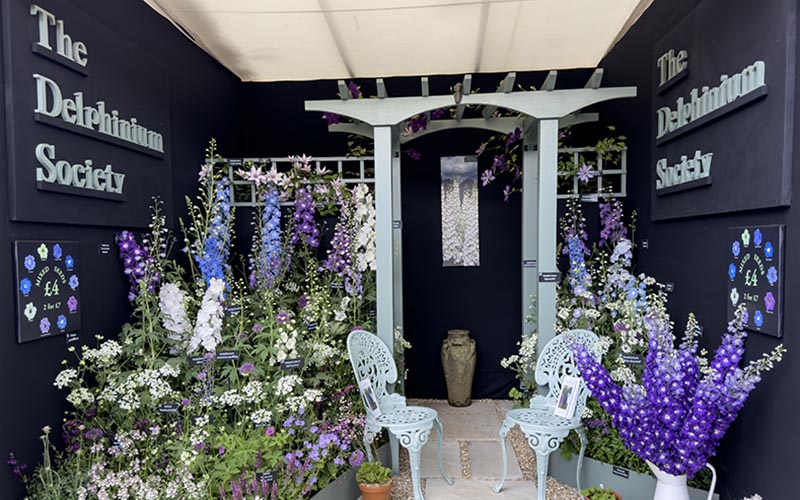Hampshire nursery Hortus Loci are the biggest supplier of plants at the world’s greatest flower show this May, and Freefolk-based Hardy’s Cottage Garden Plants grew for two Gold-medal-winning gardens.
But that’s not all. Hampshire has a wealth of horticultural talent, so here’s what to look out for at the 2023 show:
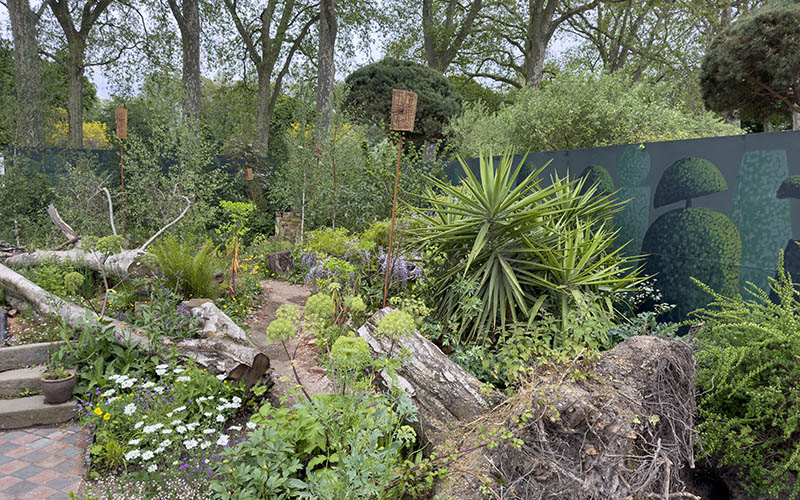
Centrepoint is the UK’s leading youth homelessness charity, providing young people with accommodation, health support and life skills to get them back into education, training and
employment.
The garden explores the notion of ‘home’ to recognise the charity’s work in supporting young people who are experiencing homelessness. The structure is based on the footprint of an urban Victorian townhouse that has fallen into decay. Nature has taken over the house, giving it a new lease of life and a sense of renewal and optimism.
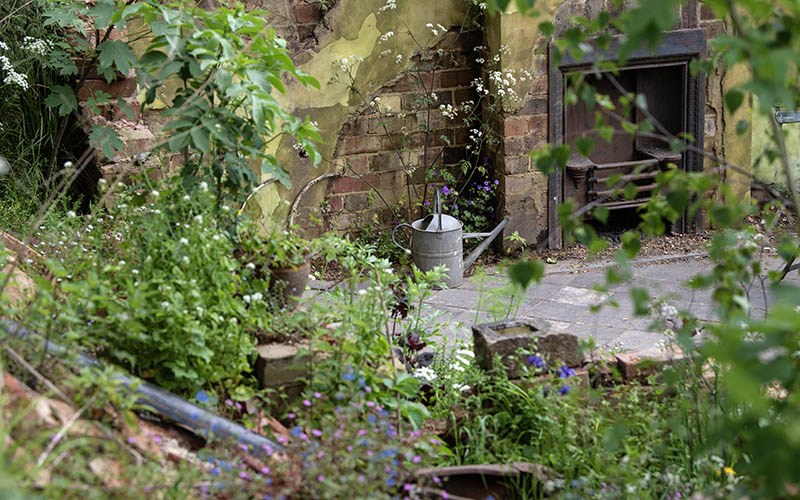
Low, fragmented walls indicate the footprint of the demolished house and an uprooted birch tree serve as a metaphor for displacement and being abandoned. The naturalistic planting of saplings and wildflowers co-exist with ornamentals and survivors from the original domestic garden, offering a new home for other lifeforms through the decay.
Elements of the garden will be distributed to Centrepoint’s service locations in the UK following the show.
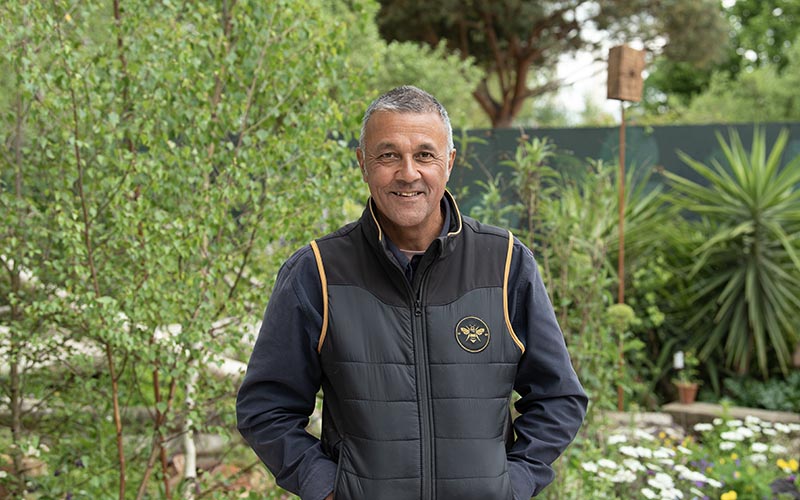
Planting/Colour Scheme
Cordyline australis and Yucca gloriosa, typically seen in urban Victorian gardens represent the original garden. Elder and hawthorn have self-seeded, birch seedlings, wildflowers, grasses, ferns and ornamentals. Plants by Hortus Loci.
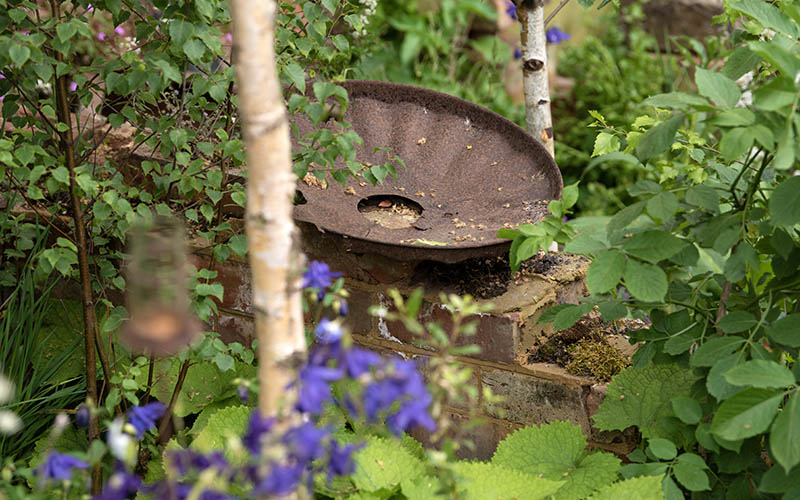
This garden represents the medicinal herbal colony located in the eastern part of Jirisan, also known as “the mother mountain of Korea”. This area is home to 15,000 or more species of native medicinal plants. It is the last primeval forest of Jirisan where Korean native medicinal herbs, specialty plants and rare endangered alpine plants grow. In Korea, the human body is believed to work as the universe operates. In ancient time when hospitals and pharmacies were nonexistent, diseases were cured using medicinal plants growing wild in mountains and fields. Human life was dependent on nature for survival.
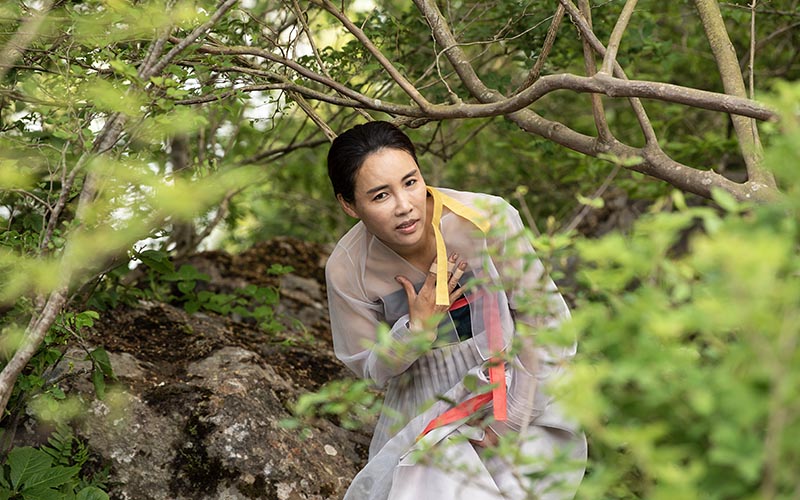
This garden highlights how the recovery of the natural environment is key to the coexistence between humans and nature and how this can be made possible by minimising human interference.
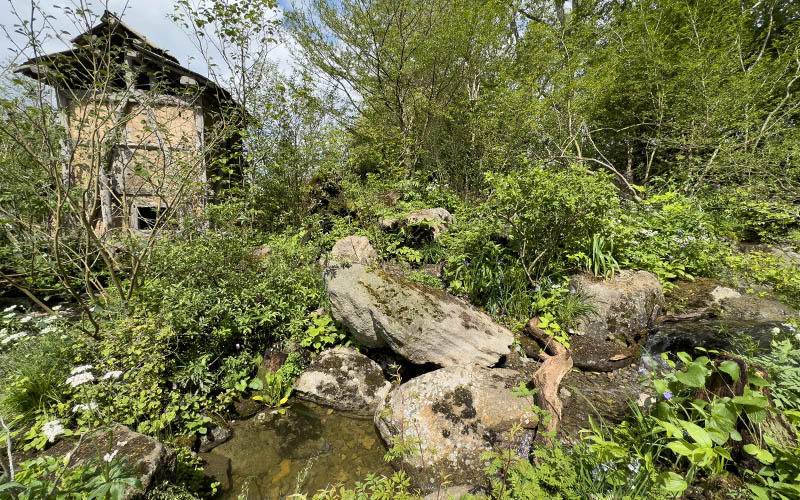
Planting/Colour Scheme
Key plants include Filipendula formosa and Maianthemum bicolor along with many other plants with medicinal properties which were nearly extinct but now thrive on Jiri mountain following rewilding work. Plants by Hortus Loci.
Myeloma UK supports patients coming to terms with their diagnosis of bone marrow cancer and strives to improve standards of care through research and education.
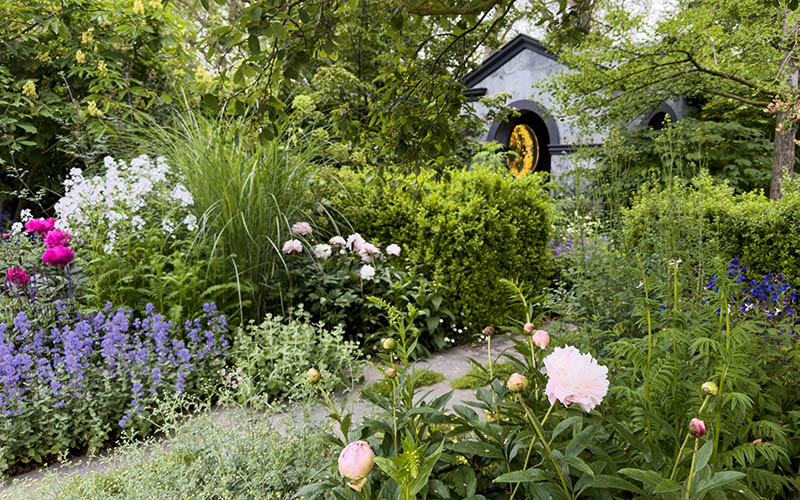
The garden is intended to provide a personal space for reflection, to celebrate life and to offer an uplifting and positive experience for those living with myeloma. Formal and structured areas are balanced with more informal woodland plants and shading. An architectural ‘temple of life’ offers retreat, a partly enclosed space with glimpsed views of the wider garden and an audible water spring for calming effect.
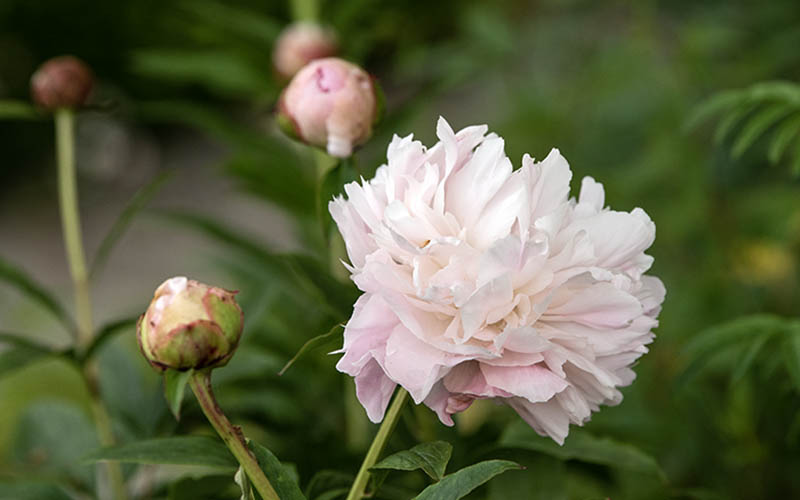
Planting/Colour Scheme
Informally arranged trees and shrubs in standard and multi stem forms to develop a layered canopy offering dappled shade and filtered views of features on progression through the garden space. Hedges are used to create division of space, muted tones and cameo planting within a designed geometry. Plants by Hardy’s Cottage Garden Plants.
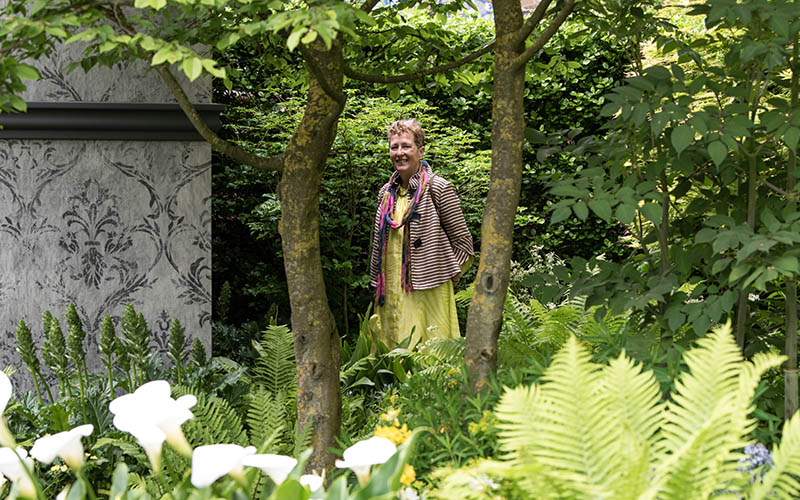
The outdoor lab, built into a hillside, takes visitors down into the landscape, offering an ‘insect eye view’ and a space in which to study. A movable projector screen links to the microscopes in the lab, giving the opportunity to show enlarged insects at magnified scale, revealing their fascinating morphology and offering opportunities for education. The lab’s roof structure is inspired by a compound insect eye and will provide ‘modules’ permeable to insects, providing an accessible opportunity for on-site research, study and identification.
During the week of the show, the lab will be used for real scientific research, monitoring and studying insects visiting the garden.
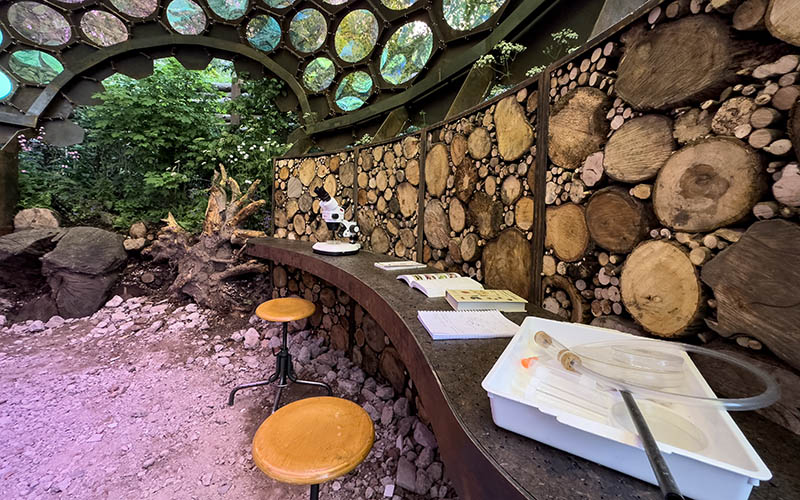
Diverse topography across the garden – from rammed earth floors, hoggin pathways and dead wood, to piles of rubble, bare sand and gabion walls – provide numerous and varied habitats for insects. Water in still pools and flowing streams provides additional important insect habitats and added interest to the aesthetic and soundscape of the garden. A dead tree ‘sculpture’, cut into rings elevated on steel poles, ‘floats’ over biodiverse planting – the open structure allowing ease of access for study. A standing dead tree and tree stump provide further sculptural habitat and visitor interest.
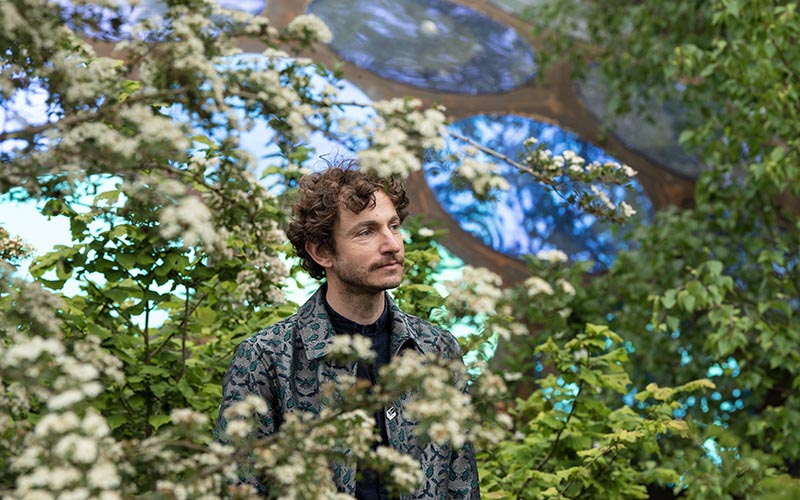
Planting/Colour Scheme
Planting for pollinators and a wide range of other beneficial insect, has been designed with our changing climate in mind, adapted to showcase a beautiful and resilient scheme that will provide year-round food, habitats and interest.
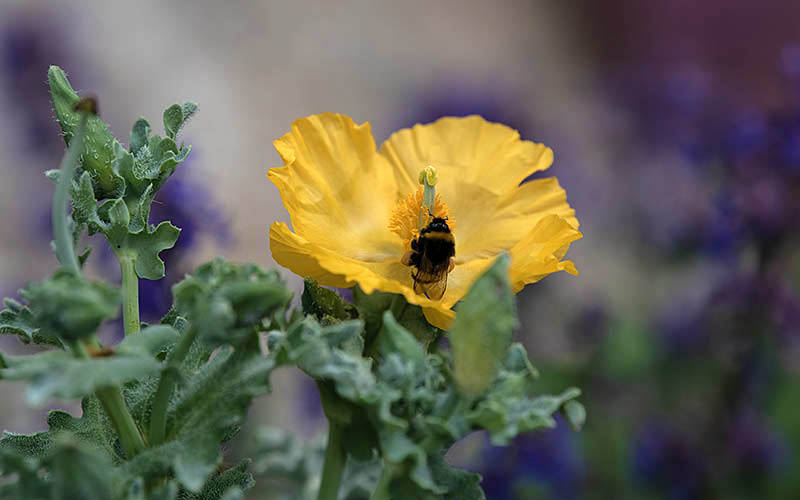
At the front of the garden, colourful and textural drought resistant planting – mulched with mixed recycled aggregates – is representative of plants found on brownfield sites.
Naturalistic planting behind the lab evokes native woodland edge meadows, buzzing with insect life. The planting will contain a mix of native and non-native plants, extending the garden’s flowering season and providing a mix of food sources for pollinators and other beneficial insects. Plants by Hortus Loci.
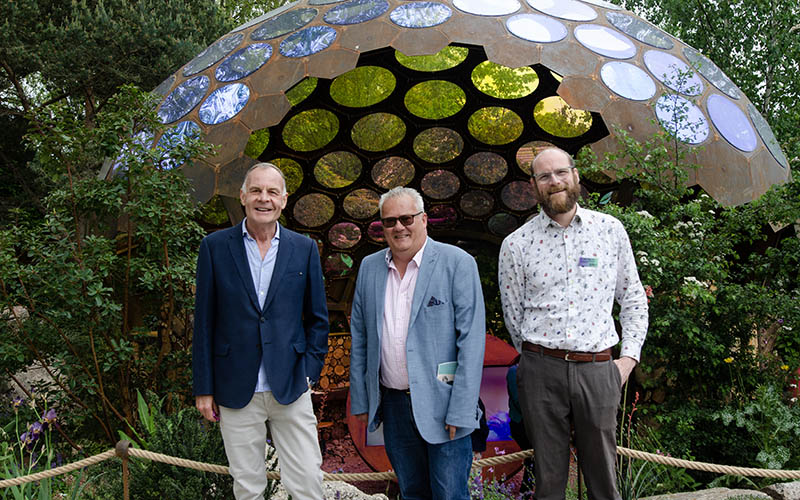
The garden is imagined as part of the home of a young couple who want to relax and enjoy spending time in an outdoor environment.
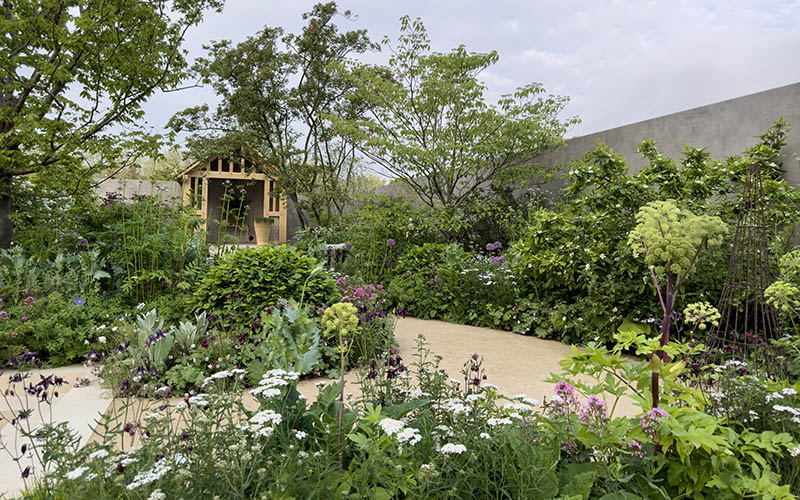
Using minimal hard landscaping to create a contemporary space, the couple have been inspired by the knowledge of previous generations to create more traditional flowering beds which give a sense of a country garden.
A series of three open spaces, intended for small gatherings will feel enclosed and at times
will be submerged in planting. A hand built oak pavilion forms the centre piece of the garden.
Planting/Colour Scheme
Traditional cottage garden plants form the backbone of the planting with an informal mix of
herbaceous perennials and structural shrubs. Plants by Hortus Loci.
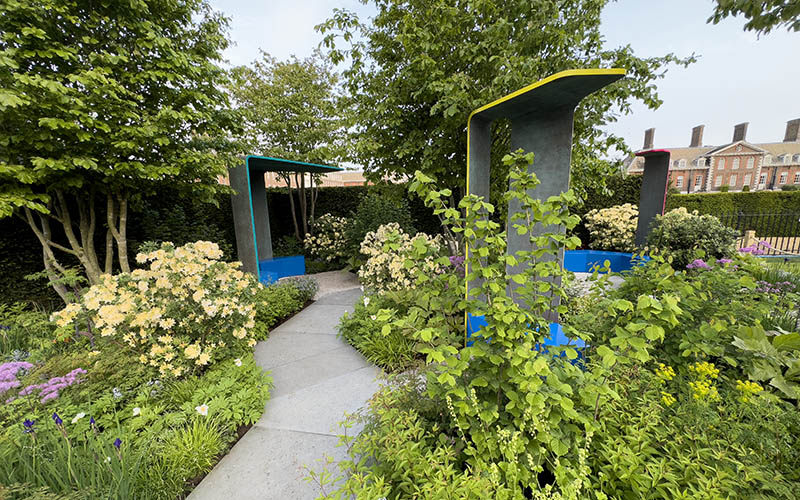
The National Brain Appeal’s Rare Space Garden has been designed alongside people living with rare dementias, using their lives to inspire a space that will foster autonomy, hope and encourage activity among people affected. These are non-memory led dementias that can make seeing, understanding, and moving confidently through physical spaces extremely challenging.
The result is a space of contrasting materials to help identify and locate structural components and a simple layout that offers a balance between exploration and calm navigation. Central to this is a level path which turns through the garden, offering along its way three seating areas with visually contrasting shelters of various colours to promote independent wayfinding. Together these elements showcase a bespoke environment for people living with rare dementias so they can find a place of enjoyment and refuge in a challenging world. The garden highlights the exceptional work of the charity in funding world-leading research to address and support those with rare dementias and other neurological conditions.
Planting/Colour Scheme
The garden uses a colour scheme of pink, purples, blues and reds with some flashes of light yellow. Key plants include Rosa glauca and Parrotia persica with a dense canopy to minimise dappled light coming through which can be confusing for people living with certain are forms of dementia. Plants by Hardy’s Cottage Garden Plants.
Bringing together a community is the living thread weaving through every aspect of this garden. A place to meet, to share food and escape to connect with nature and relax.
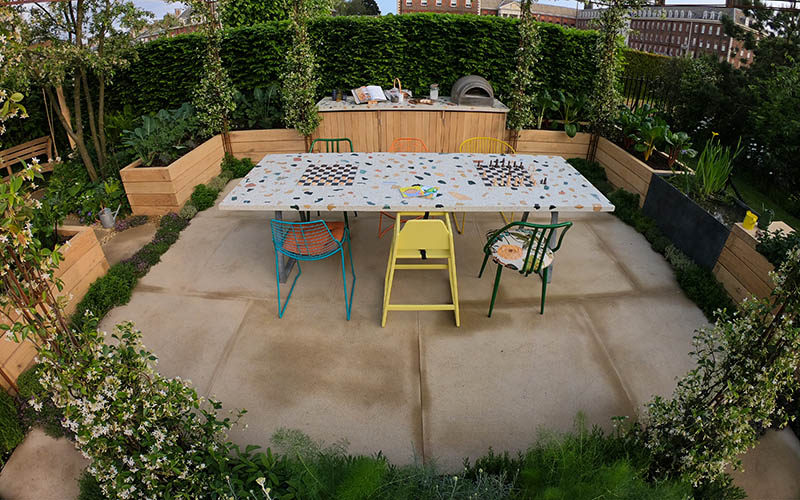
There are two contrasting areas of what would be a larger garden. A welcoming meeting space is facilitated by a large communal table and borrowed chairs, each representing a personal story. Areas
have been designed for growing produce and sharing, playing games, or sitting under the shade of a pergola. The garden provides a calming oasis to connect with nature – with a tranquil planted area, a swing seat for unwinding and a spot under the dappled canopy of a tree.
The garden reflects London Square’s ethos of providing that vital connection between people through communal gardens at the heart of the neighbourhoods it builds.
Planting/Colour Scheme
Planting is a mix of lush green textures with purple, white, and pink flowers. The produce section of the garden has a mixture of vegetables and herbs. Plants by Hortus Loci.
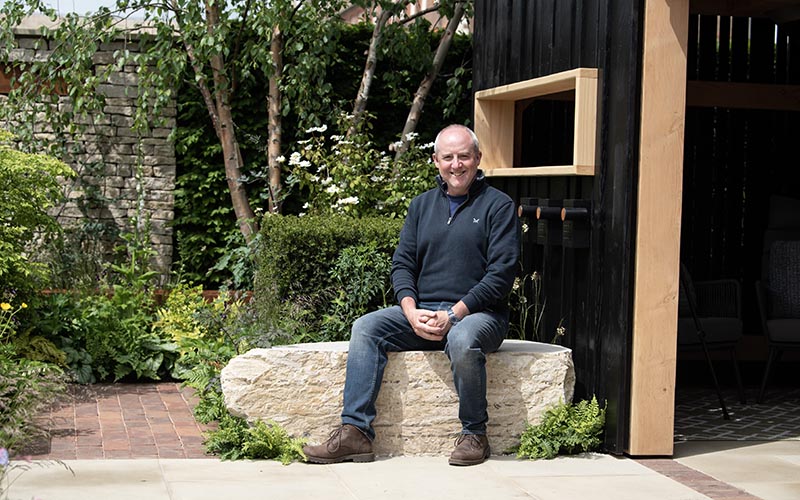
The garden is a contemporary interpretation of a wildlife sanctuary, inspired by native woodlands and the rehabilitation of wild animals that forms part of the RSPCA’s vital welfare work.
Created using a fusion of natural, sustainable and recycled materials, it demonstrates how we can have a positive impact on biodiversity and live as part of the natural environment.
In the corner of the garden sits a contemporary structure akin to a wildlife observation hide,
enabling views out into the space. A natural stone feature wall, with contemporary bird nesting boxes, forms the rear. Laser-cut corten steel contains a modern interpretation of a ‘dead hedge’, which becomes a habitat for birds, mammals and insects, using recycled garden waste.
A rill, framed from recycled plastic, flows through the garden, creating movement and sound. It cascades into a pool, providing a spot for quiet contemplation, as well as a source of water for wildlife.
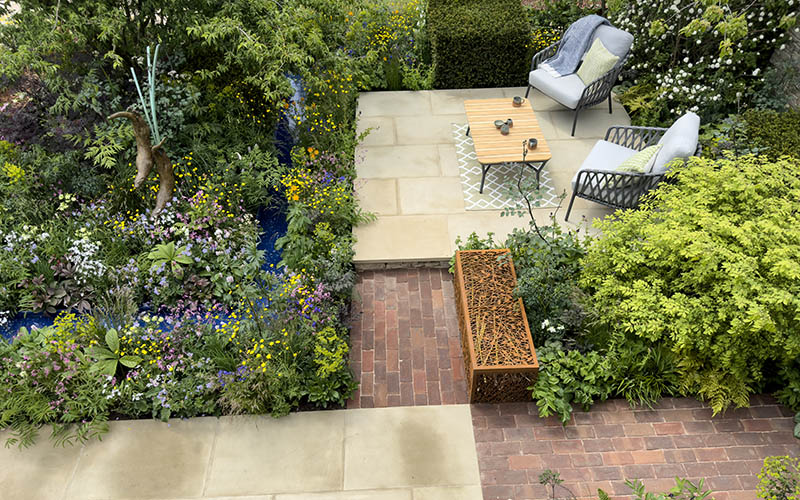
The whole space is enclosed by hedging and a canopy of native trees and shrubs, essential for birds and wildlife. Planting is in a multi-layered naturalistic style, in shades of green, whites and tones of ‘RSPCA’ blue, with pollinator-friendly plants.
The garden is a celebration of the 200th anniversary of the RSPCA, the largest animal welfare charity, which will continue to rescue, care for and prevent cruelty to all animals for the next 200 years and beyond. Animals are at the heart of this garden. Through its repurposing of litter that has harmed some of the many animals the RSPCA rescues, the garden inspires visitors to create safe, inclusive outdoor spaces for all creatures to share.
Planting/Colour Scheme
A calming palette of greens and whites contrast with darker clarets. The garden’s planting is inspired by a woodland setting in a multi-layered naturalistic style, enclosed by hedging and a canopy of native trees and shrubs that can be easily replicated in domestic gardens to inspire visitors to create safe, inclusive outdoor spaces for all creatures to share. Plants by Hortus Loci.
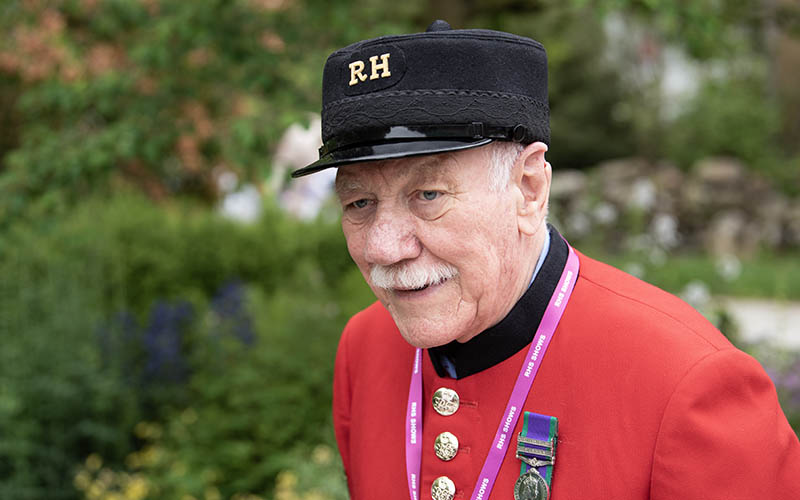
Talitha Arts use the integrative arts to bring about transformation in the lives of those who have suffered trauma. The garden is a celebration of the creative arts and their therapeutic power to restore lives. It is a planted canvas, a living installation that speaks of restoration through creativity.
250 handmade white porcelain butterflies, created by Japanese ceramicist Naoko Tagai, pour from a large sculpted chrysalis, made by Norfolk-based stone carver Teucer Wilson. This illustrates the sanctuary that Talitha Arts provides, and the transformational power of their creative workshops.
The garden unites sculpture, performance and planting – representing the wide spectrum of
therapeutic arts.
Planting/Colour Scheme
A minimalist pallet of two main colours conveys the delicate moment between darkness (trauma) and light (transformation). Textural planting reflects the depth and complexity of trauma. Sculpture alongside performance ignites the stage to convey the simple message that the creative arts have the power to transform lives. Plants by Hortus Loci.
The garden is an immersive, forageable and naturalistic landscape where children can explore nature and be inspired by a diverse range of edible, climate-adapted plants along the way.
Paths are child-sized, allowing children to create their own imagined worlds as they meander through plants, scramble over boulders and journey past the raw elements of food production: tactile rammed earth walls, reflective water, flowers to attract pollinators and light-capturing grasses.
Calming textural planting is intersected by bold, colourful ribbons of flowers, leading to a tranquil space where children can express their views on food and climate change through direct quotes painted on the central wall.
All elements culminate in a show-stopping way and deliver a prominent message: nutritious food, a healthy planet and access to nature are fundamental rights that every child should enjoy.
Planting/Colour Scheme
The main body of planting is green and textural with soft pastel colours, blues and pale pinks
for a calming effect. This is contrasted by ribbons of pollinating plants in strong hot colours,
which weave through the garden, enlivening the senses. Plants by Hortus Loci.
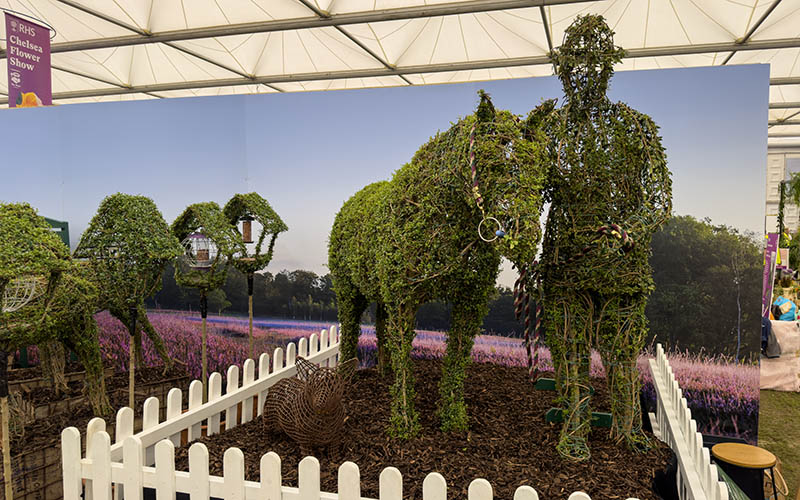
Look out for Agrumi Topiary Sculptures at GPB027 who won Silver, and New Forest Hostas and Hemerocallis at GPF086 who won Gold.
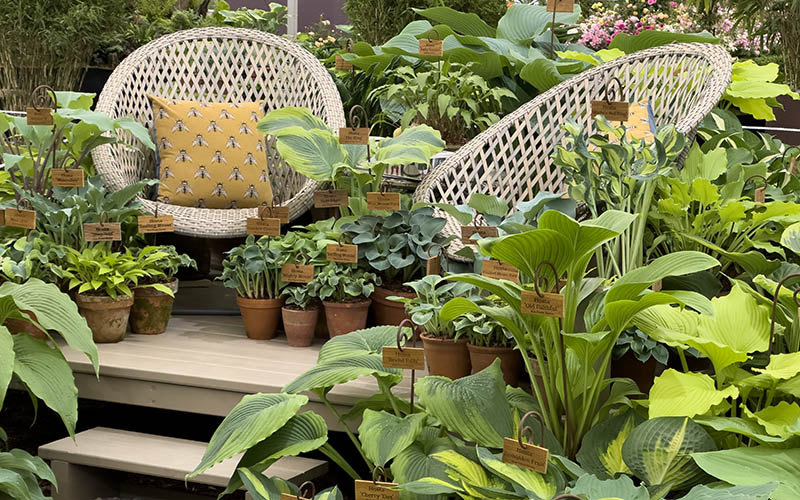
You can see more plants from Hardy’s Cottage Garden Plants if you find the coronation crown.
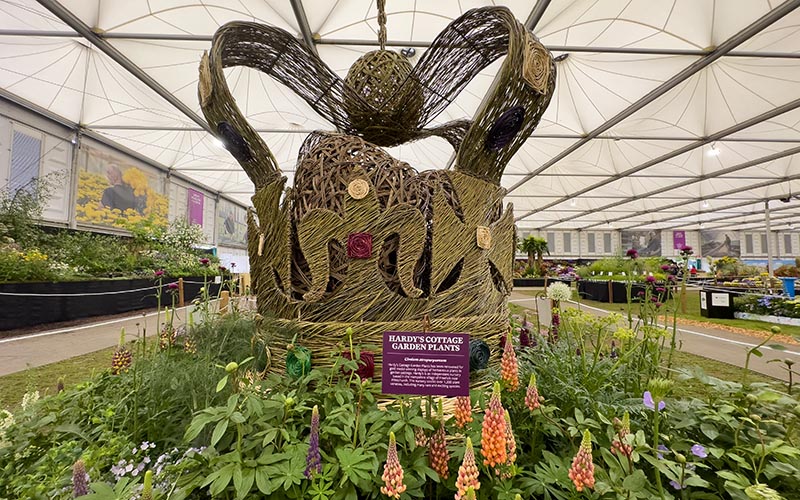
The Sparsholt College team (GPA008) have created ‘Rustic Recipes Reimagined’ which is inspired by tasty recipes from medieval cookery books that can all be foraged from the local countryside or grown in UK gardens. They won Best Discovery Exhibit.
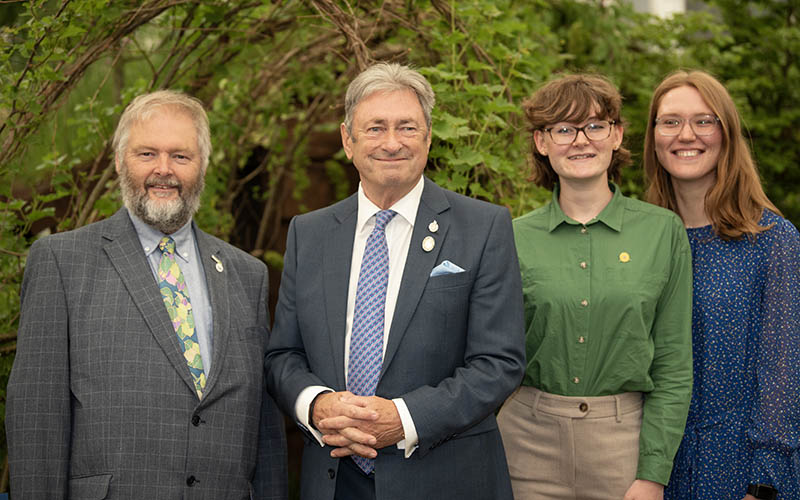
Harkness Roses have launched rose Sense and Sensibility this year after Hampshire author Jane Austen.
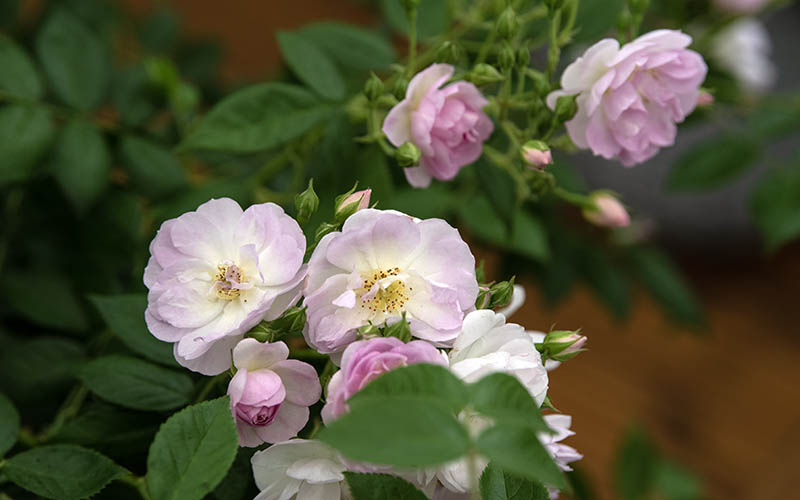
Also look out for rose Lady Carnarvon at their stand in the Great Pavilion – it was launched last year and is named after Lady Carnarvon, Countess of Carnarvon who calls Highclere Castle home.
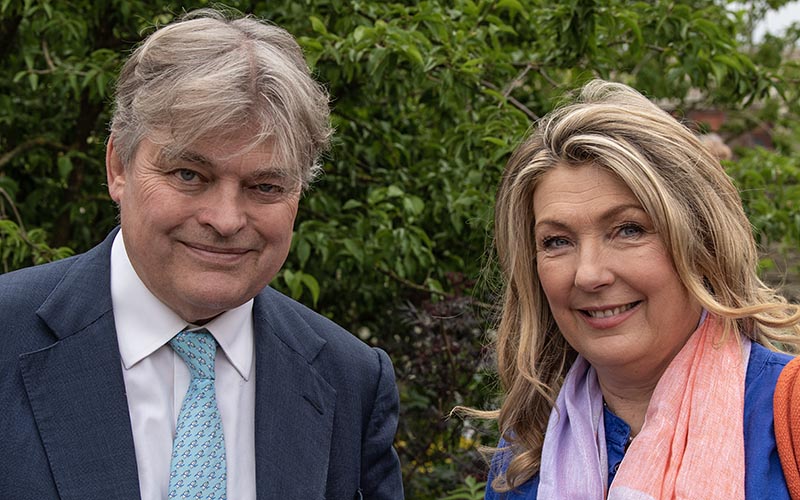
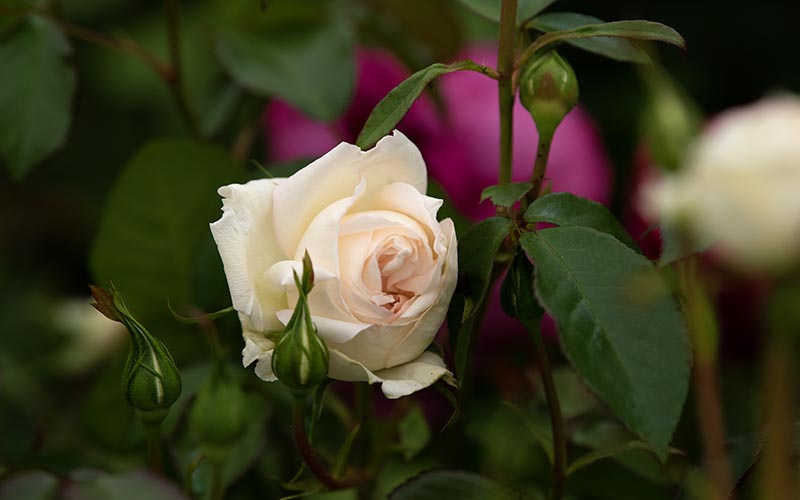
Hampshire nursery Hillier made the shortlist for Plant of the Year and are responsible for four of the 19 plants recognised.
Sparsholt College’s stand included all of these plus the eventual winner, Agapanthus BLACK JACK (‘Dwaghyb02’).
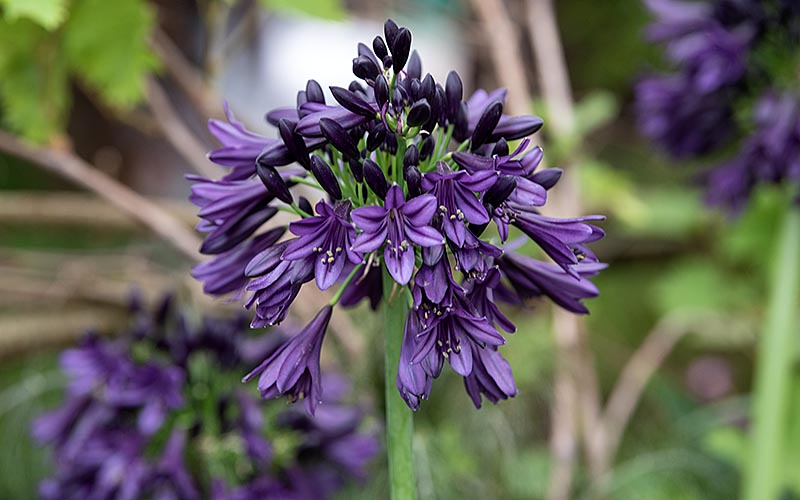
Southampton-based floral designer Pip Bensley chared the judging panel for the hybrid panel and Marie-Louise Agius was Chair of Show Garden Judges.

Rob Hardy from Hardy’s Cottage Garden Plants mentored Kitchen Garden, Home Farm Plants, JJams and new exhibitor Lincolnshire Ponds who were awarded Gold.
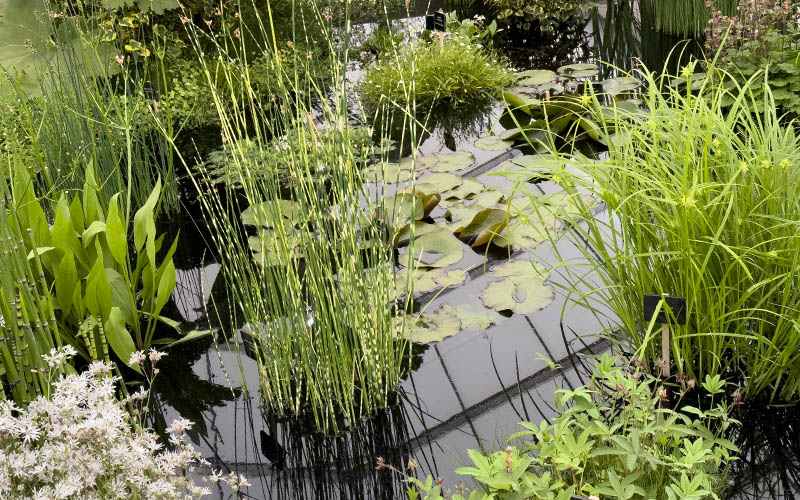
Unmissable on Main Avenue are Alitex Ltd (MA336 ) – Victorian aluminium greenhouses and Gaze Burvill Ltd (MA335) – oak outdoor kitchens and furniture.
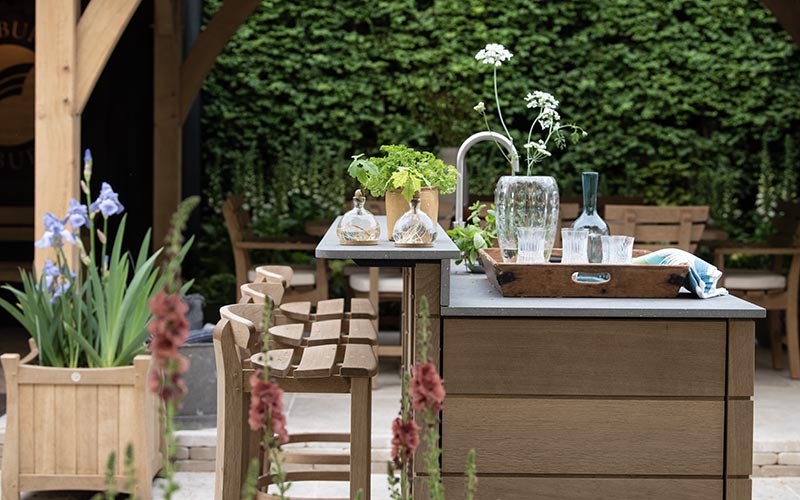
Also exhibiting are:
